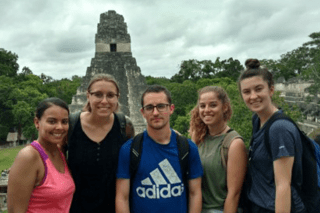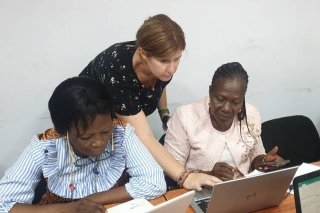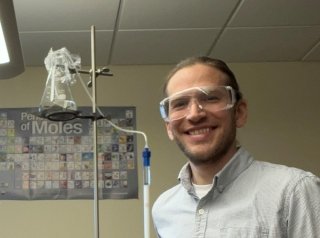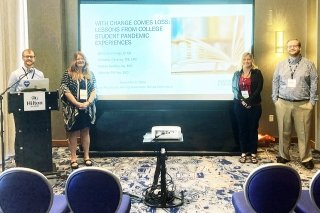Uncovering a Mayan mystery
Posted:

A summertime dream destination for many is Disneyland. For archaeologists and adventurers alike, their dreams lay hidden deep in the jungles of Guatemala. This past summer, Bloomsburg University student Arianna Ambrosio joined the few given an opportunity to achieve such a dream.
Working under Bloomsburg University anthropology professor Damien Marken and Guatemalan archaeologist Damaris Menendez, a discoverer of the ancient Royal Snake Lord Tomb, the anthropology major spent her summer excavating an ancient Maya household in archeologists’ goldmine of El Peru-Waka’, Peten Guatemala.
Although leaving family and the norms of everyday life behind to live in tent houses buried in remote jungles for months was a daunting suggestion, Ambrosio was confident it would all be worth it in the end. After taking a class on the Aztecs and Maya, her interest in that region of the world had peaked and nothing short of experiencing it herself would satisfy that itch.
From the first day she arrived, Ambrosio was fully immersed in Guatemalan life.
“Living in the jungle was definitely the best, the strangest, and most challenging all at once,” Ambrosio said.
“I loved waking up every day to the loud sounds and wildlife of the jungle, and seeing monkeys in the trees on my 20-minute hike to work every day, even the creepy crawlies like the tarantula that liked to hangout outside my tent or the lizards that would run away from me on my way to the bathroom,” she recalled.
During her time in Guatemala, Ambrosio said she “worked with local workers and got to learn from them not only about the archeology, but about the jungle and the local culture, which is everything to an anthropologist.”
The anthropology student said “there were the expected stares of being a foreigner and the language barrier, but that wasn’t so bad. I almost liked experiencing all these new things at once from an outsider’s perspective, but I learned quickly how some things never change cross culturally
Ambrosio said that during the time she spent in the jungle, “I became friends with local Guatemalans and learned so much Spanish.”
“Being Hispanic, it meant the world to connect with that side of my own heritage.”
When she wasn’t working, Ambrosio was using her time off to sight-see and indulge her hunger of curiosity.
“I loved being able to visit other sites and learn from other professionals in the field while seeing beautiful architecture and structures that were thousands of years old,” she said.
“Visiting other parts of the country on our days off was so valuable to me, I loved being able to see Tikal most of all.” Tikal is an ancient Maya citadel that was once one of the most powerful kingdoms of an ancient empire.
Ambrosio said, “I was able to experience so many beautiful ruins in the country and was able to learn about the archeological community.”
She was even given the chance to visit Naranjo, a place she described as “a hidden gem in the jungle that contains an intricately reconstructed palace that you can climb on and experience without limitations, including a view of the jungle top that was incredible.”
After being given the opportunity to explore and experience the life of an archaeologist, Ambrosio has clarity in what she wants to do after Bloomsburg University.
The anthropology major said that the trip “gave me the means of knowing where to point my career and how to do it. I also learned a plethora of different specializations within the field of archeology that I could potentially point my interest in. Most of all, it taught me so much about archeology and gave me the possibility and flexibility to pursue archeology as a career full time.”
Ambrosio stated “the experience gave me everything I needed to excel in archeology, not only at Bloomsburg University, but to get involved with the professional world. Not only did it give me enthusiasm for my future in archeology, it showed me what it’s going to take to pursue this career and where I can end up in the future.”
Overall, she determined that “there are some things you can’t understand about a place until you have fully dedicated and immersed yourself into the culture and the area.”
Ambrosio’s summer trip to Guatemala put her in a world unlike anything she had ever experienced and pulled her away from everything she had ever gotten used to, but she says “I’ve come to realize the opportunities and experience I have had and will have make everything worth it.”
The data collected by Arianna Ambrosio over the summer will be used by the Waka’ Archaeological Project in junction with National Geographic to reorganize the chronology of the Mayan development.
Summer 2019 (May-August)
Damien Marken continued his research as director of the Waka’ Archaeological Project (PAW) in Guatemala. Accompanying him in the jungle doing fieldwork this summer were two Bloomsburg URSCA recipients, Arianna Ambrosio and Bailey Gemberling, as well as alum Zac Cooper ‘16. Ambrosio assisted Marken and Guatemalan archaeologist Damaris Menendez excavating a household of crafting artisans in the hinterlands of the ancient Maya city of El Peru-Waka’, Peten, Guatemala, while Gemberling and Cooper continued the ground verification of a recent LiDAR survey of the region.
Following the May-June field season, two additional BU students, Abigail Cruz and Andrew Miller, and another alum, Emily Haney '18, now a master’s student in archaeology at Brandeis University, joined the team in the PAW lab house in Guatemala City along with graduate students from Tulane University and Yale University and faculty from Tyler Junior College in Texas, the College of Wooster in Ohio, and the Dallas Museum of Art.
There the students were trained in the analysis of archaeological ceramics and completed a massive addition to the PAW ceramic database. Not only will these data be invaluable for PAW researchers reconstructing the occupational chronology and economic organization of the ancient city, they will also serve as the basis for presentations and future research by the students themselves.



